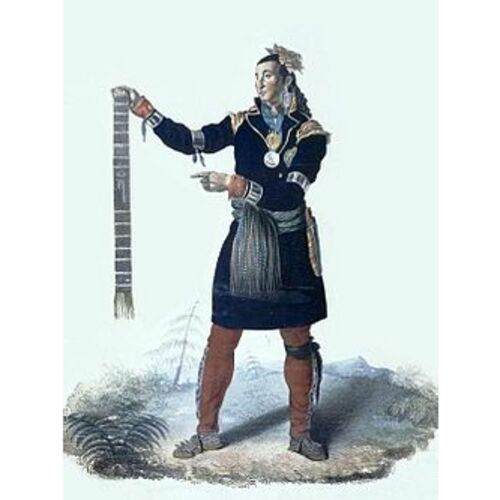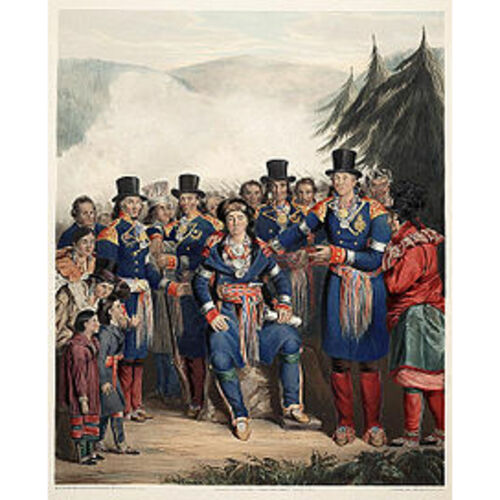
Source: Courtesy of Wikimedia Commons
VINCENT, NICOLAS (baptized Ignace-Nicolas; called Tsaouenhohoui, “one who plunges things into the water,” or “the hawk,” the name of the hereditary civil chief of the Hurons of Jeune-Lorette), grand chief of the Hurons; b. 1769, probably 11 April, in Jeune-Lorette (Wendake), Que., son of Louis Vincent (Sawantanan) and Louise Martin (Thodatowan); m. there first 24 Nov. 1794 Véronique Petit-Étienne, a Huron, and they had nine children, one of whom, Christine, lived until 1903; m. there secondly 22 Jan. 1821 a Malecite named Madeleine, widow of Pierre-Jacques Thomas of Penobscot (Castine), Maine; d. 31 Oct. 1844 in Jeune-Lorette.
In 1699, without the knowledge of the Hurons, the French crown made over to the Jesuits the title to the seigneury of Sillery, which had been granted in 1651 to the Hurons and the other Christian Indians living there. Only after the suppression of the Society of Jesus by Pope Clement XIV in 1773 did the Hurons realize that they were no longer entitled to the dues derived from the working of their lands at Sillery. In 1791, alarmed and reduced to abject dependency, they initiated legal proceedings which were to extend over nearly half a century. In these proceedings the principal figure was Grand Chief Nicolas Vincent.
Their first petition seeking restitution of the seigneury of Sillery to the Huron nation was addressed to Governor Lord Dorchester [Carleton*] in 1791. They sent similar requests almost every year to each governor from Robert Prescott* to Lord Dalhousie [Ramsay]. A typical petition, dated 13 Dec. 1823, reads: “The Petitioners conceive that the King of France could not validly give to the Jesuits that which he had already bestowed on the Indians. The Petitioners further represent that the other Indians of this country . . . are in the undisturbed possession of the Seigniories which the French Kings permitted them to retain in their own country. That the Petitioners alone, victims of the simplicity of their ancestors, and of the cupidity of the Jesuits, are divested of all, and reduced to utter poverty; even so that in a country of which their ancestors once were masters, they have lost all the right even of hunting, and dare no longer enter the forest, where they are daily expelled with violence by the proprietors, who consider them as malefactors, and treat them accordingly.”
By 1824 all the Huron families despaired of getting any real attention paid to their difficulties and so entrusted their chiefs with the mission of travelling to England and making representations to King George IV on their behalf. On 15 November Nicolas Vincent, grand chief of the council of the Huron nation since 1810, along with André Romain (Tsohahissen) and Stanislas Koska (Aharathanha), council chiefs, and Michel Tsiewei (Téhatsiendahé), war chief, embarked on the brig Indian. In the first three months of 1825 “the four Canadian chiefs” had conversations with various members of parliament and, more important, they met with the colonial secretary, Lord Bathurst, who showed them great consideration and arranged for their living expenses to be paid by the government.
On 8 April 1825 the king received the four Huron chiefs, as their people had ardently hoped. The London Times reported the exchange between the Huron grand chief and the British sovereign in the course of this “ceremony.” The audience began with George IV personally hanging around the necks of the four chiefs silver-gilt coronation medals bearing his likeness.
Grand Chief Vincent then made a speech in French to the sovereign that was an admirable and brief example of Indian rhetoric: “I was instructed not to speak in the royal presence unless in answer to your Majesty’s questions; but my feelings overpower me; my heart is full; I am amazed at such unexpected grace and condescension, and cannot doubt that I shall be pardoned for expressing our gratitude. The sun is shedding its genial rays upon our heads. It reminds me of the Great Creator of the Universe – of him who can make alive and who can kill. Oh! may that gracious and beneficent Being, who promises to answer the fervent prayers of his people, bless abundantly your Majesty! May he grant you much bodily health; and, for the sake of your happy subjects, may he prolong your valuable life. It is not alone the four individuals who now stand before your Majesty who will retain to the end of their lives a sense of this kind and touching reception; the whole of the nation, whose representatives we are, will ever love and be devoted to you their good and great father.”
Speaking to Vincent and the other chiefs in French, George IV replied that he had always respected the fine people of the various tribes in his North American possessions and that he would take every occasion to enhance their well-being, ensure their happiness, and show himself to be truly a father. He then conversed with them in French and in the most gracious manner for more than a quarter of an hour.
The British press probably was not informed of the contents of the Hurons’ petition, but reported that a promise had been made to the chiefs that territorial compensation would be granted to their nation if “certain lands” taken from them could not be given back. During the remaining four months of this venture in high diplomacy, which was of capital importance for all the Indian people, the Huron chiefs developed the strategies they would use to claim the return of their territory and consolidated their knowledge of the political workings of the British empire.
Assured of the sympathy and support of the highest imperial authorities, Vincent as chief made representations on several occasions to the Lower Canadian House of Assembly concerning his tribe’s various grievances, particularly in the matter of hunting rights. In 1819 he officially addressed the assembly, the first Huron to do so. He spoke again quite often in the coming years, always in the Huron language, and his messages were translated by his older brother Louis Vincent (Sawantanan), who had his baccalauréat, or Michel Tsiewei. His statements, which were recorded in the minutes, show that he had an acute sense of responsibility, a shrewd mind, and a noble attachment to his people’s traditional values.
In January 1829, at the request of the colony’s government, which wanted to clarify the territorial boundaries of each of the seven Indian nations in Lower Canada, chief Vincent took on the task of making a reconnaissance of the traditional Huron lands and producing a map of them. The “Vincent” map matched the pictographic data on a wampum belt describing the territories; later that year chief Tsiewei explained the belt at Trois-Rivières in the presence of the chiefs of Indian nations concerned and the superintendent of Indian affairs at Quebec, Michel-Louis Juchereau Duchesnay. The superintendent attested to the authenticity of the agreements, which were confirmed by the “truth” belts.
The final Huron chief to bear the name Tsaouenhohoui, Nicolas Vincent was one of the last hereditary chiefs, since the native system of choosing chiefs disappeared around the 1880s, after an elective method was instituted by the Canadian government. Chief Vincent died at 75 years of age and was buried on 2 Nov. 1844 in the Huron cemetery. On 5 November the Quebec Mercury observed: “The Grand Chief Nicholas Vincent . . . was the nephew of the late Grand Chief [José Vincent]. . . . The deceased was an eloquent orator in his native tongue, and particularly distinguished for his personal dignity and gracefulness of manner.” Three portraits were painted of Vincent. The first was done by Joseph Hermeindel, an English artist and engraver, at the time of the Huron chiefs’ stay in London in 1825, the second by the Huron artist Zacharie Vincent* around 1835, and the third by artist Henry Daniel Thielcke at Jeune-Lorette after the bestowal of an honorary chieftainship on an Englishman in 1838. All show the grand chief as a tall, alert man with fine features and a dignified air.
ANQ-Q, CE1-28, 11 avril 1769, 22 janv. 1821, 2 nov. 1844. L.C., House of Assembly, Journals, February 1819, February 1824. La Minerve, 7 nov. 1844. Quebec Mercury, 5 Nov. 1844. Times (London), 12 April 1825. R. C. Dalton, The Jesuits’ estates question, 1760–1888: a study of the background for the agitation of 1889 (Toronto, 1968). “Les chefs hurons auprès de Georges IV,” BRH, 11 (1905): 347–50. Victor Morin, “Les médailles décernées aux Indiens d’Amérique; étude historique et numismatique,” RSC Trans., 3rd ser., 9 (1915), sect.i: 310–11. “Mort de la plus vieille sauvagesse de Lorette,” Le Soleil (Québec), 3 oct. 1903: 11.
Cite This Article
Georges E. Sioui (Atsistahonra), “VINCENT, NICOLAS,” in Dictionary of Canadian Biography, vol. 7, University of Toronto/Université Laval, 2003–, accessed December 20, 2025, https://www.biographi.ca/en/bio/vincent_nicolas_7E.html.
The citation above shows the format for footnotes and endnotes according to the Chicago manual of style (16th edition). Information to be used in other citation formats:
| Permalink: | https://www.biographi.ca/en/bio/vincent_nicolas_7E.html |
| Author of Article: | Georges E. Sioui (Atsistahonra) |
| Title of Article: | VINCENT, NICOLAS |
| Publication Name: | Dictionary of Canadian Biography, vol. 7 |
| Publisher: | University of Toronto/Université Laval |
| Year of publication: | 1988 |
| Year of revision: | 1988 |
| Access Date: | December 20, 2025 |




